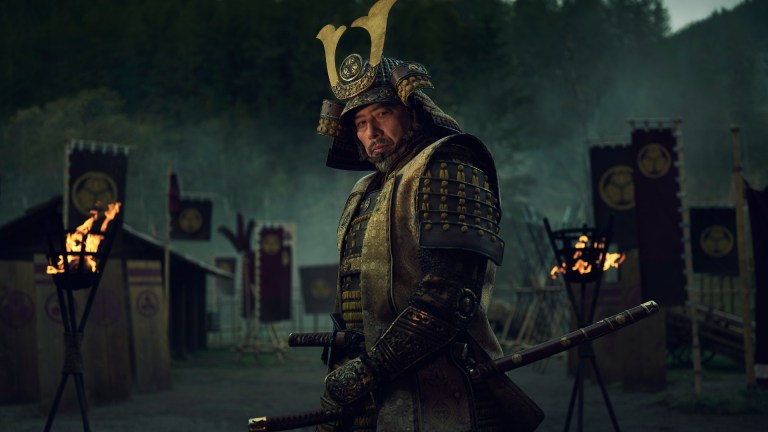The Real History of FX’s Shogun: Fiefs, Anjin, and Taiko Explained
First a book, then a miniseries, and now another miniseries: Shogun draws from a rich real life history.

This article contains details from history that could spoil upcoming episodes of Shogun.
FX’s extravagant miniseries Shōgun brings a very old story to modern audiences.
Starring Hiroyuki Sanada (who also serves as one of the producers), Cosmo Jarvis, and Anna Sawai, this 10-part limited series is based on the 1975 James Clavell novel, Shōgun, which follows John Blackthorne. A 17th century English pilot-major, Blackthorne becomes stranded off the coast of Japan, ends up captured by samurai, is forced to assimilate into Japanese life, and is thrust into the center of a political battle between those vying to claim the coveted position of military ruler, or shogun, including Lord Yoshii Toranaga.
Among the executive producers are Justin Marks and Rachel Kondo (who together wrote the first two episodes), as well as Clavell’s daughter Michaela. Before you gear up for this tale of sailors, warriors, and a lust for power, let’s break down all the details you need to know about the source material for this larger-than-life project, including some surprising connections to real-life historical figures.
Shogun: A Book, Then a Miniseries
The third novel in Clavell’s six-book “Asian Saga”, Shōgun focuses on the clash of cultures between Eastern and Western civilizations, with plenty of political intrigue and a dash of clandestine romance. However, this isn’t the first time Clavell’s tale has shown up on television, as Shōgun would first grace the small screen over 40 years ago.
Airing over five nights on NBC in September 1980, the original miniseries pulled out all of the stops and in the same vein as 1977’s Roots, was treated as a major television event. Boasting colossal production value and shot on location in Japan (which was an anomaly at that time), Shōgun was an epic experience with an appropriately epic cast. Starring Richard Chamberlain, John Rhys-Davies, Yoko Shimada, and Toshiro Mifune as Toranaga (plus voiceovers by Orson Welles), Shōgun would not only continue to set the bar for the genre over the next two decades and beyond, but would help generate interest in Japanese culture.
Often classified as one of the most highly-regarded and viewed miniseries of all time, it also hit awards paydirt, with 14 Primetime Emmy award nominations and three wins, as well as several Golden Globes wins. Chamberlain would appear in another ratings bonanza three years later as Father Ralph de Bricassart in 1983’s The Thorn Birds, and thanks to these two roles alone, he would be colloquially known as the “King of the Miniseries”.
For this ‘80s child, while the miniseries genre as we experienced it disappeared in the early 2000s, those memories still linger fondly in the heads and hearts of myself, my fellow Gen Xers and our parents. Shōgun was phenomenal then and has remained so since.
When Shogun Takes Place in Japanese History
Shōgun takes place in the year 1600 and picks up in the aftermath of the death of a ruler with the title of “Taikō” (meaning retired regent). Into the power vacuum steps five regents from their five competing fiefdoms to strive for influence: Lords Toranaga, Kiyama, Sugiyama, Ohno, and Ishido.
Blackthorne (known as an “anjin” or “pilot”) is dropped into new surroundings where the samurai possess an abundance of authority and clout, therefore he is completely out of his element and must acclimate quickly, whether he likes it or not. His vocal animosity towards the Portuguese Jesuit clergy he encounters indicates his adherence to Protestantism, tying back to England’s religious majority during the rule of Elizabeth I from 1558 to 1603.
The events of Shōgun occur near the end of the Sengoku period (or Warring states period), which eventually gave way to the much more well known Edo period. Named for the former moniker of Tokyo, as well as the first shogun of said period, Tokugawa Ieyasu, it was “a time of internal peace, political stability, and economic growth.” The daimyo, or feudal lords, held most of the land and were secondary to the shogunate, with the warrior class of samurai one caste below. Motion among the four prevalent social classes of warriors, farmers, artisans, and merchants was not permitted and the entire system was stuck.
European trade with Asia was prevalent at the time, so there was much interaction between Japan and the various ships that came through its waters, including those from Spain and Portugal. Plus, with Roman Catholic missionaries living in Japan beginning decades prior, influences continued in converting the masses from Buddhism and Shinto to Christianity. With such a vast expansion of Christianity in the area, following the Shimabara Rebellion from 1637 to 1638, where 40,000 peasants revolted against a potential ban on the religion, the Tokugawa Shogunate prevailed and the religion was indeed banned.
What Shogun Characters Are Real?
In this vast cast, Clavell based most of the characters in his novel on real-life personages of this era, from pilot-majors to powerful rulers.
John Blackthorne was based on William Adams, a navigator who is credited for being the first Englishman to reach the coast of Japan. Adams would remain in the country, eventually serving as an advisor to Tokugawa Ieyasu and would be elevated to the status of samurai, as well as other honorifics. Leaving behind a wife and children in England, he would never return to live there again. He would enter a second marriage to a Japanese woman and father additional children. Adams died in 1620.
Lord Toranaga was based on the aforementioned shogun Tokugawa Ieyasu, who ruled from 1603 to 1605, abdicating in favor of his son, Tokugawa Hidetada. He would die in 1616.
Toda Mariko, Blackthorne’s eventual love interest, a samurai and Toranaga’s trusted interpreter, is based on Hosokawa Gracia (also known as Hosokawa Garasha), a member of a noble family and a convert to Christianity. She would be killed by a family advisor in 1600 after a siege by a rival army attempted to take her hostage.
The first two episodes of Shōgun are available to stream on Hulu now. Episodes premiere Tuesdays on Hulu and Tuesday nights at 10 p.m. ET on FX.
